You might find yourself wondering what exactly crocodiles eat to maintain their fearsome reputation. These ancient reptiles are not picky eaters; they’re known to consume everything from water-dwelling fish and crustaceans to larger land mammals, depending on their environment and size. While the diet of a Nile crocodile skews heavily towards fish, you’d be surprised at the range of prey that saltwater crocodiles tackle, including sharks. But how do these powerful predators manage to catch such varied prey, and what does this mean for the ecosystems in which they live? Let’s explore the intricate details of their hunting strategies and dietary choices.
Key Takeaways
- Crocodiles consume a variety of prey including fish, mammals, birds, and reptiles.
- Saltwater crocodiles often eat larger prey like water buffalos and sharks.
- Nile crocodiles primarily feed on fish but also target birds and small mammals.
- Freshwater crocodiles focus on smaller creatures such as fish, crustaceans, and insects.
- Crocodiles in captivity are fed diets that mimic their natural eating habits, including fish and small mammals.
Diet of Saltwater Crocodiles
Saltwater crocodiles boast a diverse diet, feasting on everything from fish and crustaceans to mammals and other reptiles. As the apex predators of their environments, they aren’t picky eaters. You might find it fascinating that these giants also take down larger, more formidable prey like water buffalos and even sharks. Their success as predators lies in their strategic hunting methods. Saltwater crocodiles are skilled ambush predators; they wait patiently, submerged near the water’s edge, before launching at unsuspecting prey with astounding speed and power.
As juveniles, saltwater crocodiles have a diet that primarily consists of insects, small fish, and crustaceans. It’s vital for their growth and development during these early years. However, as they grow, their diet shifts dramatically. You’ll see mature crocodiles tackling much larger and more challenging prey. This adaptability in their eating habits greatly contributes to their survival across diverse habitats where food sources might vary widely.
Their ability to consume a broad range of animals not only underscores their dominance in the food chain but also their importance in maintaining ecological balance. By controlling populations of various species, saltwater crocodiles promote healthier ecosystems. So, next time you’re near their habitat, remember you’re in the presence of nature’s finely tuned hunters.
Nile Crocodile Feeding Habits
Nile crocodiles primarily feed on fish, yet they also hunt birds, mammals, and other reptiles, showcasing their adaptability as opportunistic predators. These creatures exhibit a remarkable versatility in their diet, which helps them thrive in varied environments along rivers, lakes, and swamps. As a Nile crocodile, you’d mainly eat fish, utilizing your powerful jaws and sharp teeth to grip and tear your aquatic prey effortlessly.
Here’s how you, as a Nile crocodile, manage your hunting:
- Ambush Technique: You often lie in wait near the water’s edge, blending seamlessly with your surroundings. Unsuspecting prey that comes to drink or cool off becomes an easy meal.
- Powerful Attack: Once a target is within reach, you launch a swift, powerful attack, using your muscular tail for propulsion and your formidable jaws to secure the catch.
- Role in Ecosystem: Your feeding habits are vital in maintaining the balance within your habitat. By preying on various species, you help regulate animal populations, ensuring no single group dominates.
This method of hunting not only highlights your role as a key predator but also underlines the importance of your existence in maintaining ecological balance.
Freshwater Crocodile Prey
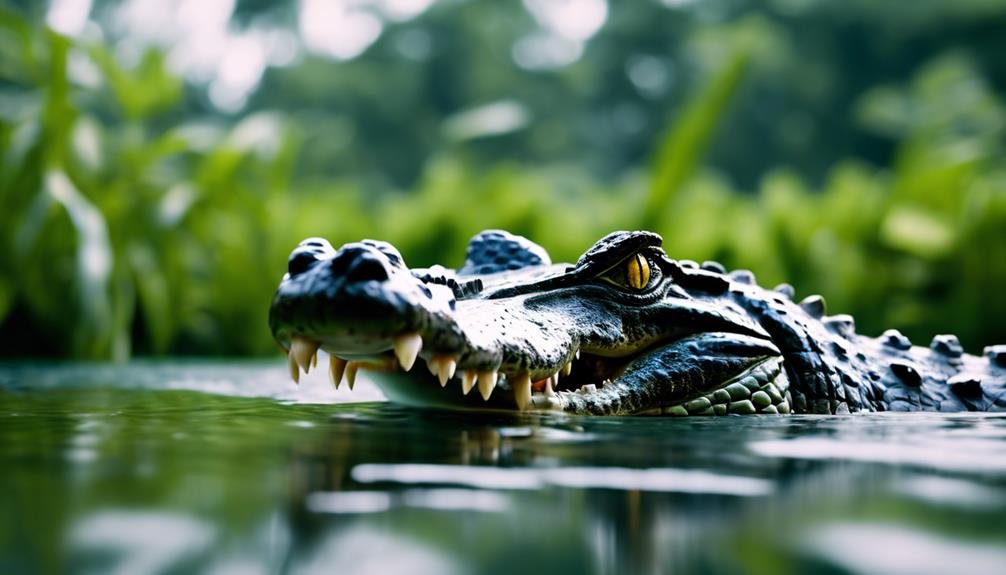

While Nile crocodiles might dominate larger prey, freshwater crocodiles focus on a variety of smaller creatures, including fish, crustaceans, and insects. As you explore the diet of these less formidable cousins, you’ll discover that their menu is quite expansive. Freshwater crocodiles eat insects avidly, making these tiny critters a staple in their diet, especially for the younger crocs.
These crocodiles aren’t picky eaters. They’ll also chomp down on small mammals, birds, and frogs that stray too close to their aquatic homes. It’s fascinating to observe how they utilize their sharp, pointed teeth, which are perfect for snagging fast-moving or slippery prey like fish and aquatic invertebrates. Small amphibians and even smaller reptiles also form part of their diet, showcasing their ability to adapt their feeding habits based on availability.
Moreover, don’t be surprised to find that freshwater crocodiles sometimes feed on carrion or scavenged remains. This opportunity feeding means they aren’t above taking advantage of a free meal, provided by the misfortune of other creatures. This varied diet helps them thrive in diverse habitats, maintaining the balance of their ecosystem.
Crocodile Diet in Australia
In Australia, crocodiles have an important role in their respective environments. By controlling the population of various prey species, they help maintain ecological balance, which in turn supports a diverse range of other wildlife.
Here are three key points about what crocodiles mainly eat in Australia:
- Freshwater Crocodiles: These smaller crocs are less intimidating but efficient hunters, focusing mostly on fish and insects. Their diet reflects the abundance of these smaller prey in freshwater habitats.
- Saltwater Crocodiles: Known as the larger and more aggressive of the Australian crocodiles, their diet is much broader. Saltwater crocs can and do eat larger prey such as water buffalo, wild boar, and occasionally sharks. Their status as apex predators allows them to dominate their food chain and maintain the balance in their ecosystems.
- Impact on Ecosystem: Both types of crocodiles play important roles in their respective environments. By controlling the population of various prey species, they help maintain ecological balance, which in turn supports a diverse range of other wildlife.
Feeding Frequency of Crocodiles
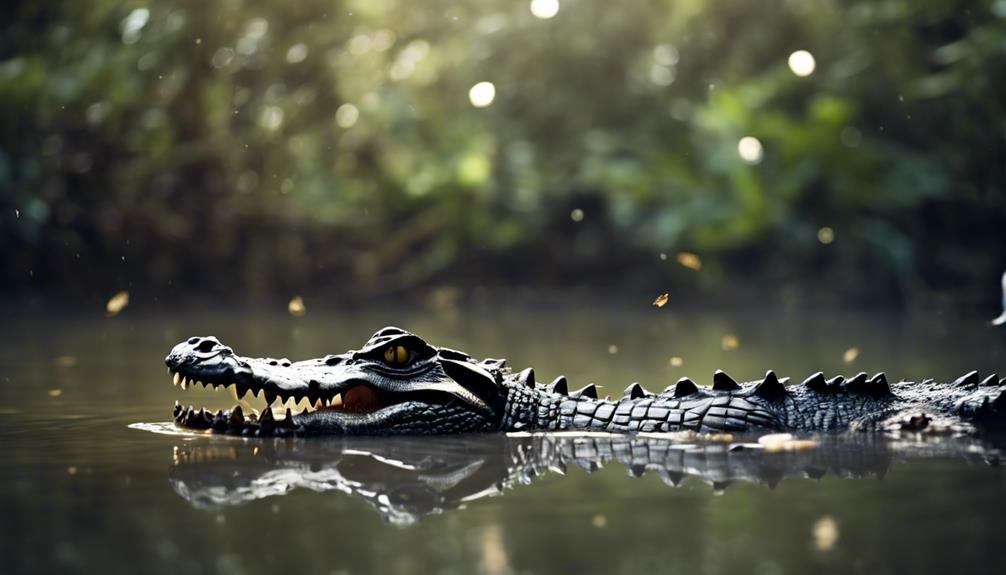

You should understand that the feeding frequency of crocodiles varies greatly based on their age and size. Young crocodiles, for instance, need to eat more often to support their rapid growth. Typically, they should be fed one to three times a week. It’s important to monitor their diet closely because, as they grow, their dietary needs will change. Crocodiles eat all kinds, but it’s important to make sure they eat the right amount.
| Age Group | Feeding Frequency |
|---|---|
| Young Crocodiles | 1-3 times per week |
| Adult Crocodiles | Less frequently |
Feeding young crocodiles about 5% of their body weight during each feeding session helps maintain a healthy diet. You’ll also want to add vitamin supplements to their meals to boost nutrition and aid in their overall development. Remember, removing any uneaten food within 24 hours is necessary to prevent decomposition and maintain hygiene. As crocodiles eat all kinds, they’re not too picky, but you must not let leftover food compromise their living conditions. Keep an eye on their growth and adjust their feeding schedule as necessary to keep them in good health.
Typical Crocodile Meal Sizes
Crocodiles typically consume meals that represent about 5-10% of their body weight, adjusting the size based on their specific needs and growth stages. As you learn about crocodiles eating, it’s important to understand how their meal sizes evolve. Larger individuals, especially, adapt their diet considerably as they grow.
Here’s a closer look at the varying meal sizes:
- Juvenile Crocodiles: When they’re young, crocodiles start off with smaller, more manageable meals. Initially, their diet consists primarily of insects and small fish. This stage is crucial for their growth, requiring frequent, smaller feedings that are easier to hunt and digest.
- Adolescent Crocodiles: As they mature, their dietary preferences shift towards larger prey. Adolescents might tackle birds, amphibians, and larger fish. These meals are substantial but still only a fraction of what they’ll consume as adults.
- Adult Crocodiles: Once fully grown, crocodiles can handle much larger meals, including mammals or even other reptiles. An adult can eat up to 150 pounds in one meal, showcasing their capacity to take down significant prey.
Feeding Times for Crocodiles
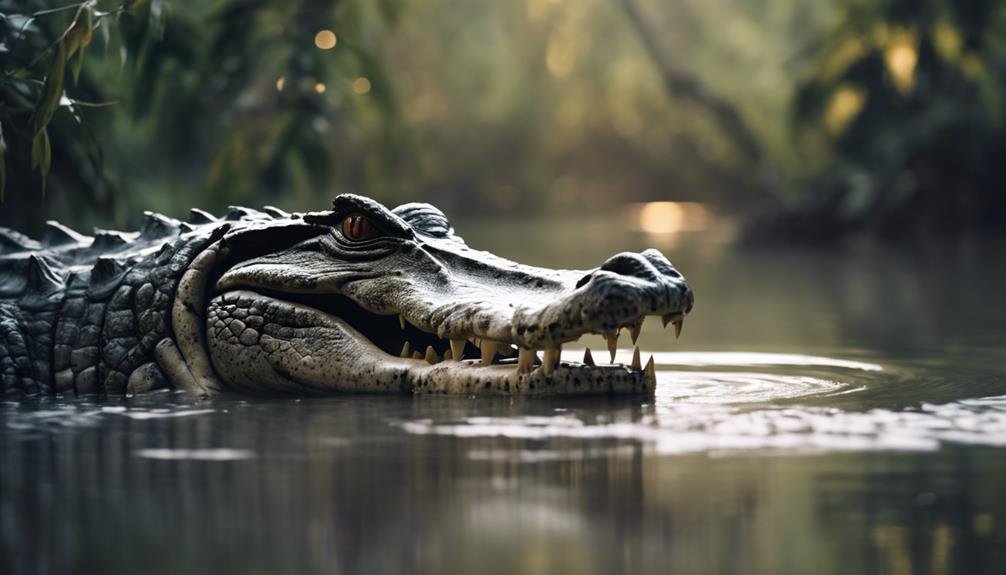

Adapting to their environment, crocodiles typically hunt at night or early morning, though they may also seek prey during the day if opportunities arise. As a crocodile, you’d find these feeding times can vary greatly depending on factors like prey availability and environmental conditions. You might also notice that younger crocodiles, being less experienced and smaller, need to feed more frequently compared to adults.
Given that crocodiles are opportunistic feeders, you wouldn’t stick to a strict schedule. Instead, you’d adjust your feeding times to when food is most readily available. This flexibility guarantees you always have the best chance at a meal, which is pretty neat for a crocodile, right? Here’s a quick glance at how your feeding might vary:
| Age Group | Typical Feeding Frequency |
|---|---|
| Juvenile | More frequent |
| Sub-Adult | Moderate frequency |
| Adult | Less frequent |
Methods Crocodiles Use to Eat
How do crocodiles manage to capture and devour their prey so effectively? Well, you’d be impressed by their strategic and powerful methods. Crocodiles are masters of ambush, using their environment to hide until the perfect moment to strike. They’ve adapted incredible strategies to attack and eat, particularly when dealing with smaller prey. Here’s a breakdown of their techniques:
- Powerful Jaws and Sharp Teeth:
Crocodiles possess extraordinarily strong jaws equipped with sharp teeth designed to grab and hold onto prey securely. Once they’ve got a hold, it’s nearly impossible for the prey to escape.
- Ambush and Sudden Attack:
They excel in stealth. Lying motionless in water, partially submerged, crocodiles can wait for hours or even days. When an unsuspecting animal comes close enough, they launch a swift attack, often catching their prey off guard.
- Death Roll:
For larger prey, crocodiles employ the notorious ‘death roll.’ They clamp down with their jaws and then twist their bodies vigorously. This spinning action helps them tear off chunks of meat from their prey, making it easier to swallow.
After capturing their meal, they might even store it underwater to soften up before consuming, ensuring they make the most out of every catch.
Zoo Crocodile Diets
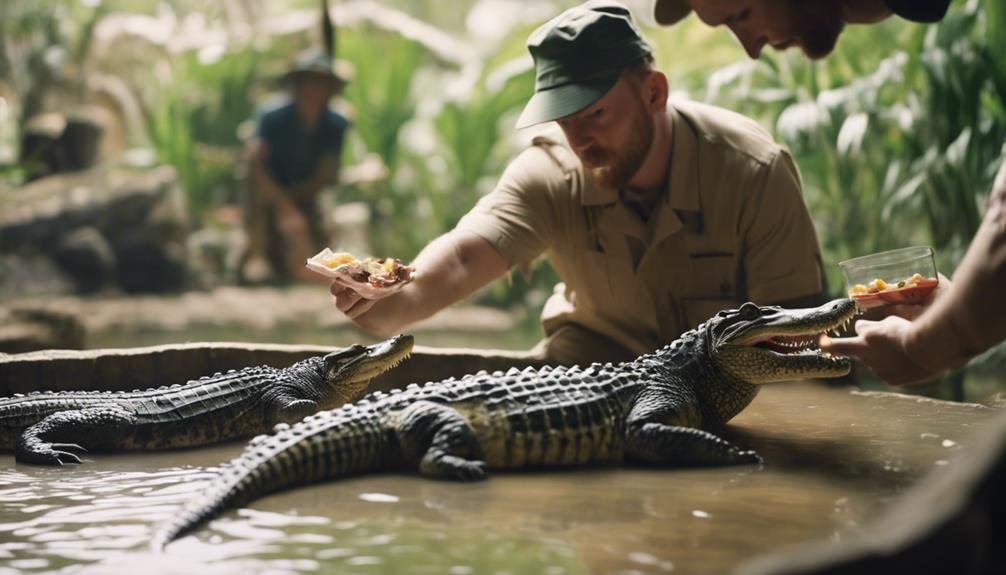

In zoos, crocodiles are provided with diets that closely mimic their natural eating habits to guarantee they maintain peak health. You’ll find these impressive reptiles feasting on a variety of foods such as fish, insects, small mammals, and crustaceans. These items ensure they receive all the essential nutrients needed for their well-being.
Zookeepers tailor these diets to cater to the specific needs of different crocodile species, considering factors like age and health. This personalized approach helps each crocodile thrive in its environment. Surprisingly, crocodiles also attack their food with vigor in captivity, much like they’d in the wild, exhibiting natural behaviors that are fascinating to observe.
Moreover, you might be surprised to learn that crocodiles eat stones. This unusual behavior aids in digestion by grinding up the food in their stomachs, a practice that’s also maintained in zoo environments to help replicate their natural conditions as closely as possible.
Providing a balanced and diverse diet is essential. It not only promotes health but also stimulates the crocodiles physically and mentally, ensuring they remain active and engaged in their surroundings. So, the careful planning and varied diet you see in zoos are crucial for these majestic creatures to lead healthy, energetic lives.
Do Groups of Crocodiles Hunt Together for Food?
Yes, a group of crocodiles called a bask can team up to hunt for food. They often work together to corral their prey and take turns attacking, making it easier to catch larger animals. This cooperative hunting behavior allows them to successfully tackle bigger meals.
Rainforest Crocodile Diet
Crocodiles residing in rainforests feast on a diverse array of prey, including fish, amphibians, small mammals, and birds. As you explore these environments, you’ll find that the abundance of water sources offers them ample opportunities to hunt. Their diet doesn’t stop there; it extends to insects, crustaceans, and other reptiles that inhabit the lush, dense rainforests.
When you’re delving into what rainforest crocodiles eat, consider these important points:
- Diversity in Prey: They aren’t picky eaters. Their diet is quite varied, helping them to adapt to the diverse ecosystem of the rainforest.
- Predation on Larger Animals: Larger crocodiles often go after bigger prey such as monkeys and sloths. They’ve even been known to eat birds that perch too close to the water’s edge.
- Ecosystem Impact: By preying on a wide range of species, they help maintain the ecological balance, controlling animal populations that might otherwise become too large.
Their role in the ecosystem isn’t just about survival; it’s about maintaining the balance that keeps the rainforest thriving. So, next time you’re considering the importance of these magnificent creatures, remember their vital role in nature’s complex web.
Conclusion
You’ve seen how diverse crocodile diets can be, from saltwater giants preying on sharks to freshwater species munching on insects. Whether it’s the formidable Nile crocodile hunting along African rivers or their Australian cousins adapting to local prey, these reptiles are masterful survivors.
Their feeding habits, from stalking large mammals to seizing fish, highlight their role in nature’s balance. No matter where they live, what they eat, or how often, crocodiles are truly remarkable predators.

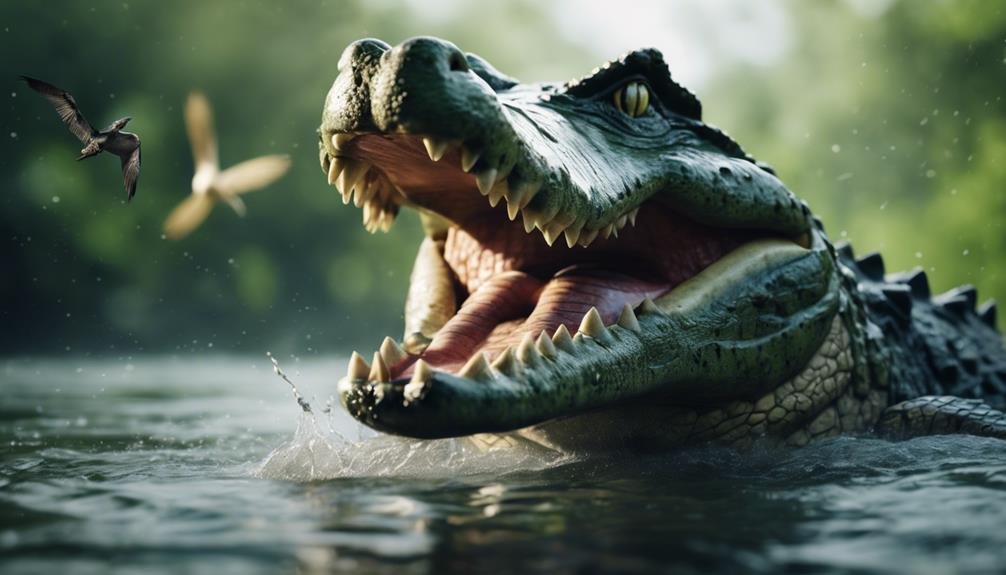

[…] Crocodiles’ diet and eating habits directly impact their lifespan. A balanced diet of fish, birds, and mammals ensures their long-term health and longevity. In captivity, a regulated diet can extend their lifespan to over 70 years. However, in the wild, environmental factors also play a significant role. […]